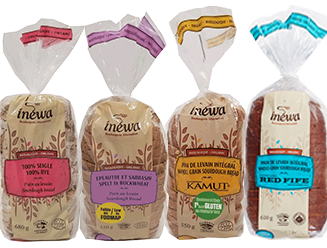The process for making bread was discovered by accident, as was the process for wine. One day crushed grapes began to ferment naturally and produce alcohol. One day a cereal paste was left without cooking and began to swell. In the beginning, the production of bread or wine was done exclusively from natural ferments. So all breads used to be sourdough.
In scientific terms, sourdough is made up of a symbiotic culture of yeast and lactic acid bacteria growing in a mixture of flour and water. Yeast feeds on the starch of wheat and excretes carbon dioxide. These gas bubbles remain trapped by the gluten in the wheat, causing the bread to “rise”. The particular acidity of sourdough bread is due to lactic acid and acetic acid produced by lactic acid bacteria.
Sourdough grows like yogurt. A small amount of leaven is used to inoculate the next dough with flour and water. The microorganisms then multiply to occupy all the dough and possibly make it rise. In this regard, the sourdoughs from the Alternative Inéwa bakery are over 20 years old!
Sourdough breads are rather rare these days although their popularity has recently shown a resurgence mainly because of their health benefits. Yeast is now used in industry to leaven bread. Yeast is much more efficient and predictable than sourdough. It provides loaves of bread that are less dense and without an acid aftertaste; on the other hand, it is much less digestible.
Cereals as well as legumes contain phytic acid located mainly in the husk of the grain (bran in the case of wheat). This acid combines with certain minerals in the gut to form insoluble phytates. It prevents the assimilation of minerals in our body (we speak of demineralization). Fortunately, under the action of phytase (an enzyme better activated in starter), phytic acid is destroyed. The higher the extraction rate of a flour, the greater its phytic acid content. The more a dough ferments, the more time the leavened phytase has to release the minerals from this association with phytic acid. In addition, the dough which rises by the action of the leaven is the beginning of fermentation; the digestion process has therefore already started outside the stomach. Sourdough bread is easier to digest than yeast bread which acts by alcoholic fermentation.
Bread is often singled out as an example of a poor quality carbohydrate because of its generally high glycemic index. However, sourdough also has the advantage of reducing this glycemic index by attacking the chemical structure of its starch. So for equal calories, a slice of sourdough bread will have a lower weight impact than yeast bread.
Another advantage of sourdough is that it neutralizes the toxicity of gluten.
Sourdough bread is nutritionally more interesting than bread made only with baker’s yeast. The taste of sourdough bread is different, more acidic and more aromatic. In addition, while yeast bread can be stored for seven days in optimal conditions, sourdough bread can be kept for a few more days because the acidity provided by the leaven slows down the retrogradation of the starch and delays the appearance of starch. mold. This is because the microorganisms in the starter act much like probiotics by occupying space and preventing other unwanted microorganisms from settling there.
Homemade yeast breads are acceptable depending on the objectives. Sometimes a lighter texture or even a more neutral taste is desired. The main downside to industrial breads is not so much the yeast as the list of chemicals used to speed up the manufacturing process. In business, time is money. In the 1950s, all bakeries required at least 8 hours to produce bread. Today industrial bakeries produce bread in less than 20 minutes. This is technologically impressive, but keep in mind that you are ingesting all of these chemicals!
For more information on our delicious products that meet many health/quality criteria; visit https://www.inewa.ca/produits (sorry! in French only for the time being..)





